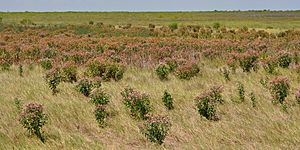Brazoria National Wildlife Refuge facts for kids
Quick facts for kids Brazoria National Wildlife Refuge |
|
|---|---|
|
IUCN Category IV (Habitat/Species Management Area)
|
|
| Location | Brazoria County, Texas, United States |
| Nearest city | Angleton, Texas |
| Area | 44,414 acres (179.74 km2) |
| Established | 1969 |
| Governing body | U.S. Fish and Wildlife Service |
| Website | Brazoria National Wildlife Refuge |
The Brazoria National Wildlife Refuge is a huge natural area in Texas, USA. It covers about 44,414 acres (180 square kilometers) along the coast. This special place helps protect many different kinds of wildlife. It is located near the towns of Angleton and Lake Jackson, Texas. The refuge is close to Christmas Bay and the Intracoastal Waterway. It is separated from the Gulf of Mexico by Follet's Island.
Contents
About Brazoria National Wildlife Refuge
The Brazoria National Wildlife Refuge was created in 1969. Its main goal is to provide a safe home for birds that migrate (travel long distances) during winter. It also protects many other types of birds and animals.
The refuge has a special freshwater stream called a slough. This stream winds through areas of salt marsh. Salt marshes are coastal wetlands that are flooded by salty ocean water.
Home to Many Birds
The Brazoria National Wildlife Refuge is a very important spot for birds. More than 300 different bird species use this area.
Winter Visitors
In winter, the refuge becomes a busy place for many birds. Over 100,000 birds come here to escape the cold. These include snow geese, Canada geese, and different kinds of ducks. Some ducks you might see are pintails, northern shovelers, teal, gadwall, American wigeon, and mottled ducks. You can also spot many sandhill cranes. They all fill the ponds and sloughs.
Summer Residents
During summer, many birds build their nests and raise their young at the refuge. You can find ten different kinds of herons and egrets. Other summer birds include the white ibis and the beautiful roseate spoonbill. You might also see mottled ducks, white-tailed kites, and clapper rails. Smaller birds like the horned lark and seaside sparrow live here too. Look for the black skimmer and the scissor-tailed flycatcher flying around.
A Network of Refuges
The Brazoria National Wildlife Refuge is part of a larger system. It works with two other national wildlife refuges on the Texas coast. These are the San Bernard and Big Boggy refuges. Together, these three refuges create a vital complex of coastal wetlands. These wetlands are crucial homes for over 300 bird species.




